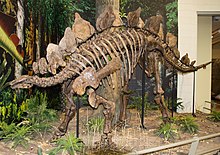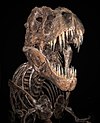Portal:Dinosaurs
IntroductionDinosaurs are a diverse group of reptiles of the clade Dinosauria. They first appeared during the Triassic period, between 243 and 233.23 million years ago (mya), although the exact origin and timing of the evolution of dinosaurs is a subject of active research. They became the dominant terrestrial vertebrates after the Triassic–Jurassic extinction event 201.3 mya and their dominance continued throughout the Jurassic and Cretaceous periods. The fossil record shows that birds are feathered dinosaurs, having evolved from earlier theropods during the Late Jurassic epoch, and are the only dinosaur lineage known to have survived the Cretaceous–Paleogene extinction event approximately 66 mya. Dinosaurs can therefore be divided into avian dinosaurs—birds—and the extinct non-avian dinosaurs, which are all dinosaurs other than birds. Dinosaurs are varied from taxonomic, morphological and ecological standpoints. Birds, at over 11,000 living species, are among the most diverse groups of vertebrates. Using fossil evidence, paleontologists have identified over 900 distinct genera and more than 1,000 different species of non-avian dinosaurs. Dinosaurs are represented on every continent by both extant species (birds) and fossil remains. Through the first half of the 20th century, before birds were recognized as dinosaurs, most of the scientific community believed dinosaurs to have been sluggish and cold-blooded. Most research conducted since the 1970s, however, has indicated that dinosaurs were active animals with elevated metabolisms and numerous adaptations for social interaction. Some were herbivorous, others carnivorous. Evidence suggests that all dinosaurs were egg-laying, and that nest-building was a trait shared by many dinosaurs, both avian and non-avian. (Full article...) Selected articleTyrannosaurus is a famous dinosaur genus and a fixture in popular culture. Known colloquially as T. rex, the species Tyrannosaurus rex hails from what is now western North America. Some scientists consider the slightly older Tarbosaurus bataar from Asia to represent a second species of Tyrannosaurus, while others maintain Tarbosaurus as a separate genus. Like other tyrannosaurid theropods, Tyrannosaurus was a bipedal carnivore with a massive skull balanced by a long, heavy tail. Relative to the large and powerful hindlimbs, Tyrannosaurus forelimbs were small, and retained only two digits. Although other theropods rivaled or exceeded T. rex in size, it was the largest known tyrannosaurid and one of the largest known land predators, measuring over 12 meters (40 feet) in length and weighing as much as an elephant. Fossils of T. rex have been found in North American rock formations dating to the very end of the Cretaceous Period; it was among the last dinosaurs to exist prior to the Cretaceous-Tertiary extinction event. More than 30 specimens of T. rex have now been identified, some nearly complete, which has allowed significant research into many aspects of its biology, including its life history and biomechanics. However, the feeding habits and potential speed of T. rex remain controversial. (see more...) TopicsSubcategoriesSelected image
Photo credit: User:Jack Mayer Wood Did you know...
Things you can do
Proposed deletions
Peer reviews
Articles to be merged
Articles to be split
Related content
Associated WikimediaThe following Wikimedia Foundation sister projects provide more on this subject:
Discover Wikipedia using portals |





























